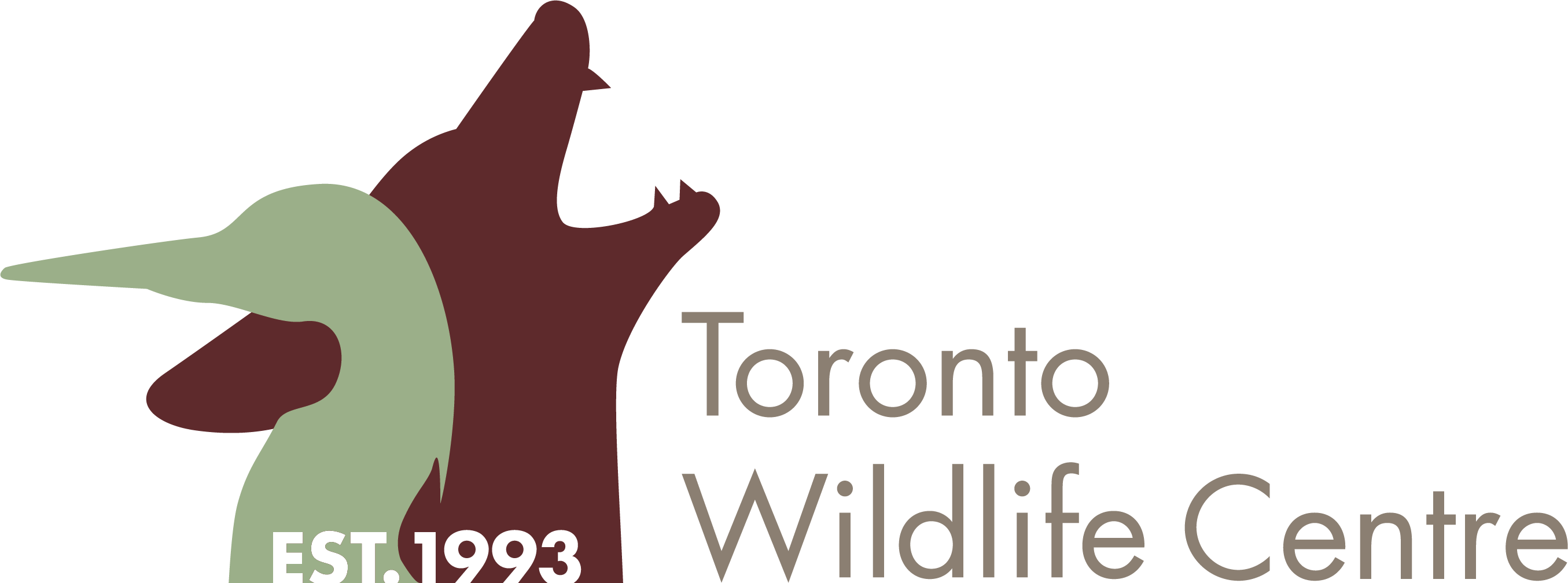By: Victoria Badham, Education and Outreach
Thud – the gut-wrenching sound of a bird flying hard into a window. Thud. It’s estimated that 25 million birds die from window strikes in Canada every year, and that number may be conservative [1]. Thud. Spread over the course of a year, that equates to 1 bird death every 1.26 seconds, from windows alone. Thud. Or about 5 bird deaths since you started reading this. Thud.

Toronto Wildlife Centre (TWC) admits hundreds of injured songbirds every year as the result of a window strike – like this hummingbird admitted during fall migration 2020. These patients receive treatment for head trauma, broken beaks and bones, eye ulcers and bleeding. Even with the best medical care possible, some will not survive due to the severity of their injuries. Preventing window collisions in the first place is critical to saving millions of birds every year.
The statistics are undeniably gloomy, but there is a bright side – compared to other threats facing birds (e.g. habitat loss due to industrial farming and logging, climate change), mitigating window collisions is a less complex issue – and a problem that is entirely preventable with a bit of effort and investment. Many technologies already exist to make windows safer for birds – if we have the knowledge and the will, there’s a way! Gaining a better understanding of why window strikes happen in the first place is the first step.

During the day, glass reflects surrounding plants, shrubs and trees; birds fly toward the reflection – to a destination that is actually behind them. Birds can also see through glass and fly toward indoor plants located directly behind windows. Many birds migrate at night and city lights draw them into busy urban areas where they become disoriented and collide with buildings.
Collisions can happen year-round and affect any bird species, but migrants are particularly at risk during spring and fall as they journey to their breeding or wintering grounds. Birds face the same challenges as they pass through any city on their flight path, across North America, and mass casualty events are not uncommon.
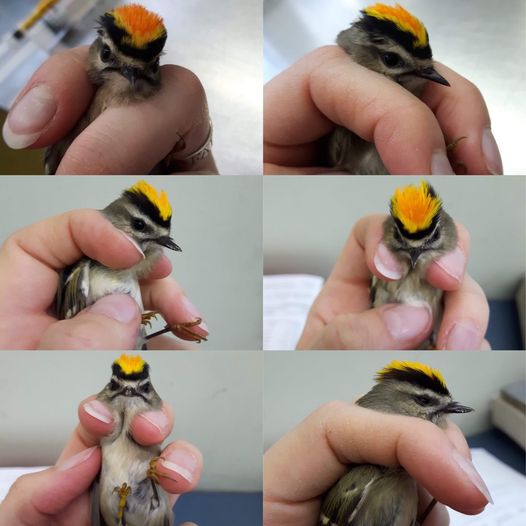
Over 300 birds were found dead on the morning of September 14th, 2021 in Manhattan at the World Trade Centre. Intense urban light pollution, an abundance of tall buildings, together with poor flying conditions, on a night of intense and low altitude migration contributed to these events (Birdcast). Sadly, TWC often admits many injured birds, sometimes dozens, from the same species in a single day because of mass collisions with windows as groups of birds pass through the Greater Toronto Area, like these golden-crowned kinglets admitted in 2018.
Although high-rise buildings are a serious issue and there’s much work to do to make these safer for birds, most window strikes happen on single-family homes and low-rise buildings (any building/window lower than the tree line) – e.g. your home! Fall migration is currently underway and there’s never a better time than now to take action!
Are you ready to help our feathered neighbours? Our friends at Fatal Light Awareness Program (FLAP) offer many affordable ways to make your windows safer for birds – from quick and easy fixes, to solutions that are more permanent. Regardless of which option you choose, there are 2 key things to remember to ensure the highest level of protection for birds: window-strike mitigation applications should be used on the outside of windows (to break up reflection), and visual markers should be spaced no more than 2-inches apart.
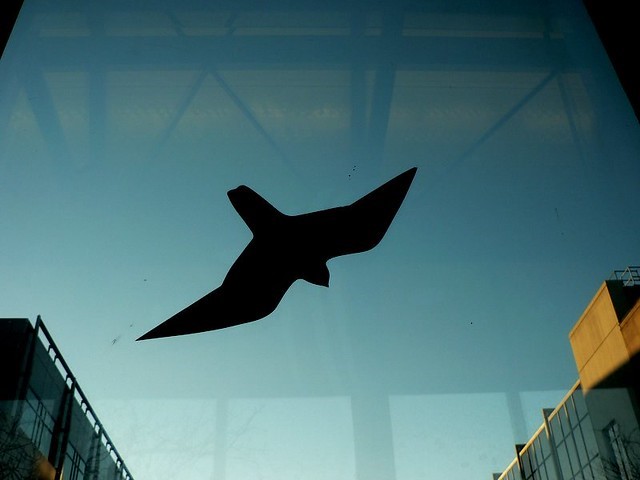
Did you know that the commonly used single flying hawk decal is not very effective in preventing window strikes? Birds will continue to fly toward the surrounding empty space.
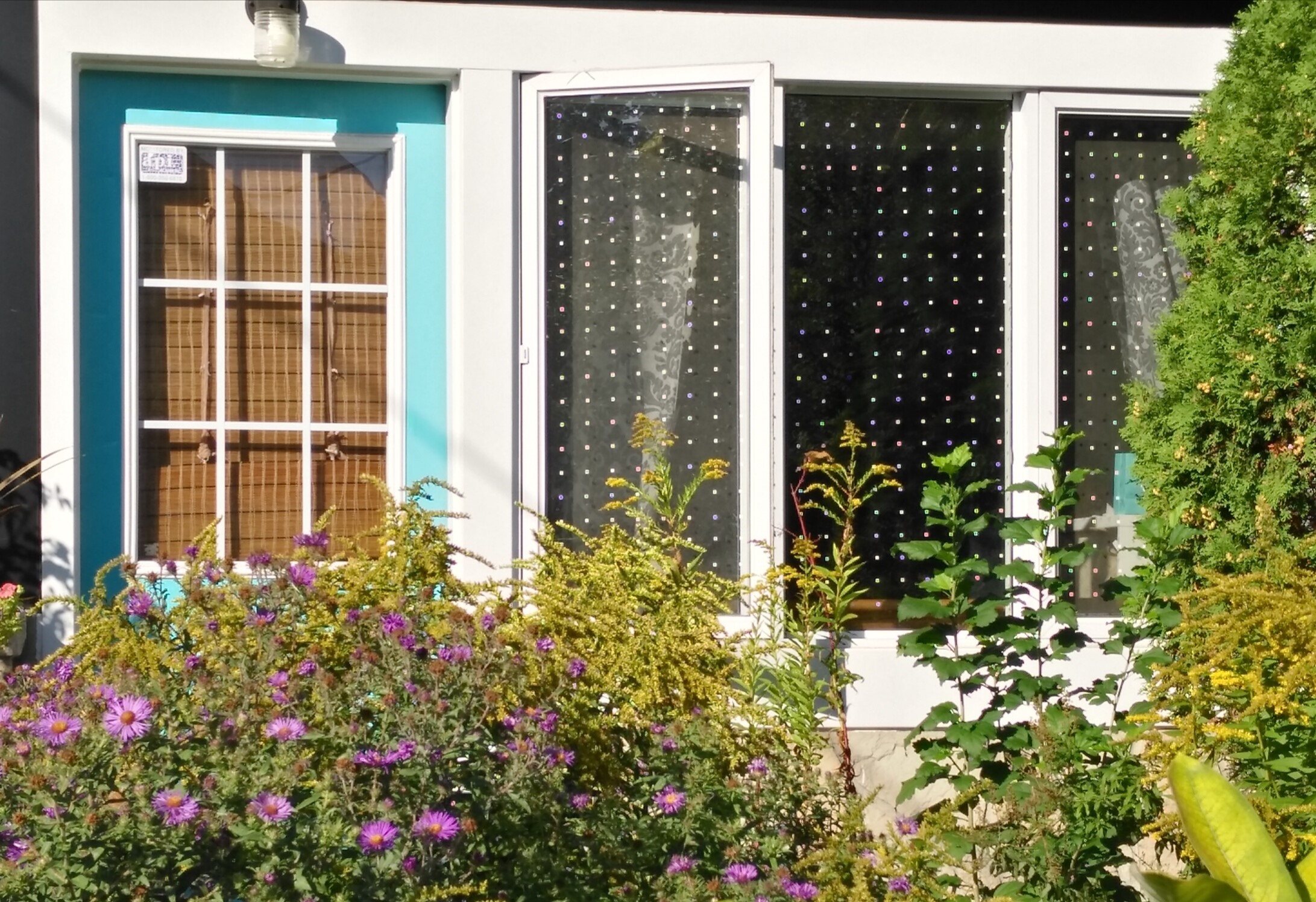
An effective and relatively cheap solution is Feather Friendly DIY tape that leaves rows of white dots on your window so birds will understand a barrier is present. For an immediate fix, a bar of soap will also do the trick! Just use it to draw lines on the outside of your window (no more than 2 inches apart). When you’re ready for a permanent solution, just wash it off!
You can help birds at night too! All you have to do is switch off lights that are not in use, especially bright outdoor lights. Switching to outdoor movement activated lights can also be helpful, as well as closing indoor curtains to reduce light emitting outside.
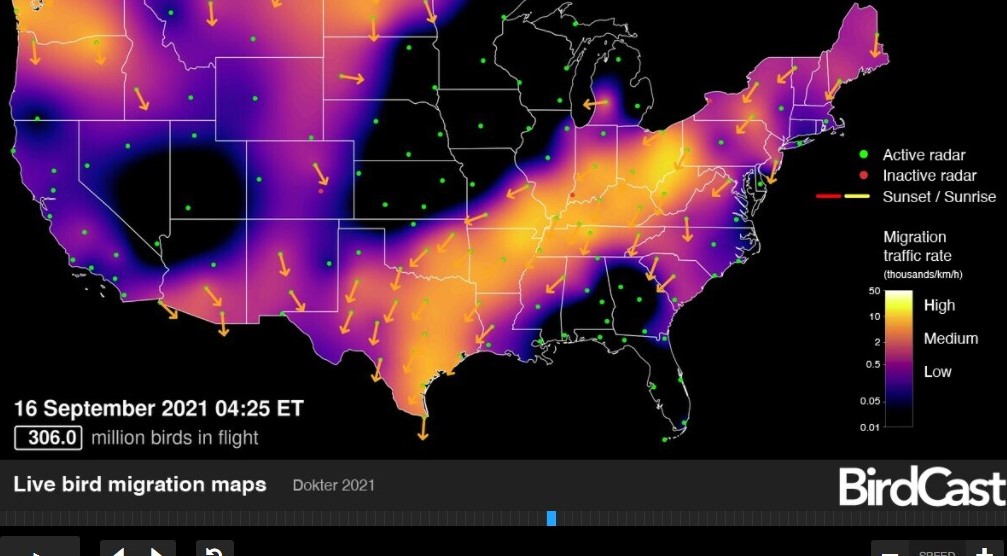
Are you interested in knowing when birds are migrating at night and where? BirdCast develops and maintains tools that predict and monitor bird migration. These include forecast bird migration maps that predict where and when bird migration will occur, live bird migration maps that show where migration is occurring in real-time, and migration alerts to which one can subscribe to learn when bird migration will occur.
When weather is bad, or when migrators need a break, they may pick your yard as the perfect rest spot and fuel station. One of the best ways to support these tired birds is to have plenty of native plants, shrubs and trees available for their use. Birds rely mainly on natural food sources that provide a variety of seed, nut and fruit options. Native plants also attract a wide variety of insects, which are critical for insectivorous migrators. Even more, plants provide critical habitat, which is equally important to food. Fall is a great season to get gardening – why not get a jump-start on supporting spring migrators by planting native species now when the weather is great for new establishing plants!
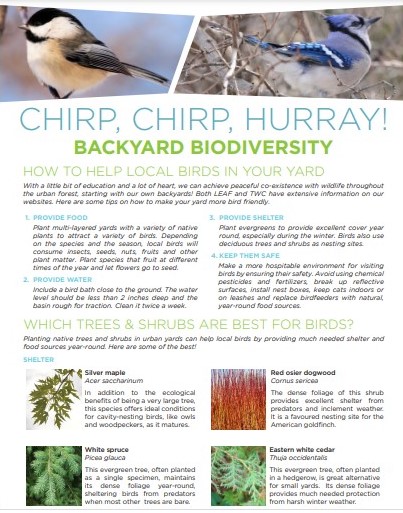
Chirp, Chirp, Hurray is an informative brochure designed by TWC’s #BackyardBiodiversity partner LEAF to guide you on the best species of trees and plants to support birds in spring/summer and fall/winter.
Many people opt to put out a bird feeder during migration. If you do, please make sure to dump out old seed once per week and wash the feeder with hot soapy water and let it dry completely before refilling. This will reduce the spread of disease (due to many birds coming into closer proximity with one another than they normally would at a natural food source).
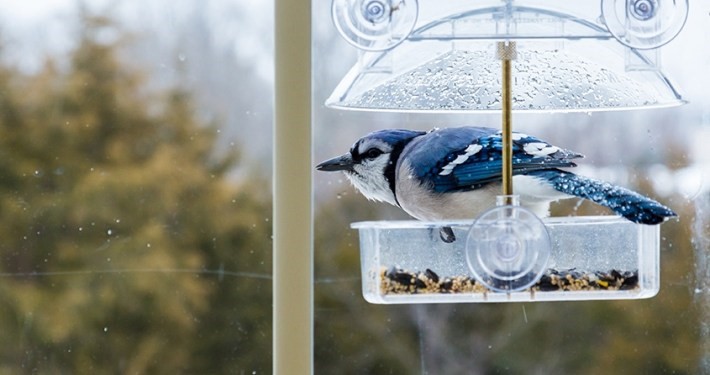
FLAP also recommends moving feeders and other bird attractants like bird baths as close to your window as possible (within half a metre, or 1.5 feet). In the unfortunate situation that a bird still collides with the window, they will be less likely to build up enough momentum to seriously hurt themselves. Otherwise, consider relocating your feeder more than 10 metres or 30 feet away from the window to also reduce the risk of collisions. And make those windows bird-safe! Remember – if we invite birds to visit our yard, we have a duty to protect them from harm! Photo: www.flap.org
If you do find an injured bird, it’s critical that they receive medical attention from a licensed wildlife rehabilitator as quickly as possible. To contain them, gently put a tea towel or small cloth over top of them and be careful with their wings. Place the bird in a paper bag, or small cardboard box with a towel at the bottom. If the bird is leaning on their side or forward, twist a small piece of cloth into a donut shape, put it on the floor of the box and place the bird in the middle of the donut, sitting upright – this will take pressure off their air sacs and help them breathe. Don’t offer food or water as it can cause further issues for a patient that is not stable, especially if given incorrectly. Put them in a dark, quiet place away from people and pets until they can be transported to a wildlife rehabilitator.
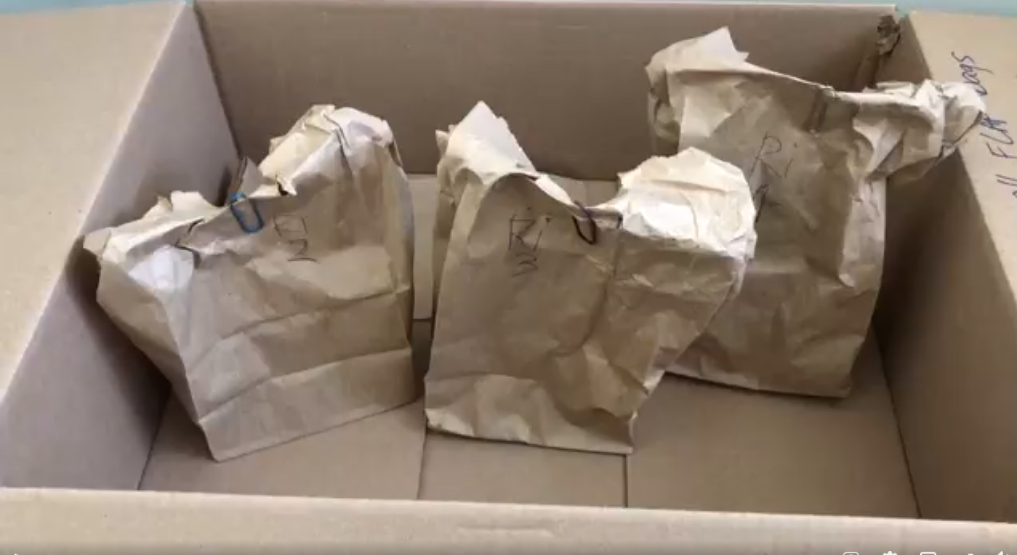
Injured birds often arrive at TWC in lunch bags like these; soft-sided containers such as papers bags and cardboard boxes are best, as they reduce visibility for the bird (minimizing stress) and don’t damage the birds’ delicate feathers.
Can you imagine how many birds have hit windows over the last few minutes? How many fewer birds would be victims if we all took the steps required to make our city safer for birds? Using visual markers – starting with even one problem window – could make the difference between life and death for one bird, or several. Together, we can help birds have a safer journey.
Want to learn/help more?
Check out this webinar from Cornell Lab of Ornithology that provides details on actions you can take around your home to help migratory birds as they move through.
Help save and track window strike victims by joining Global Bird Rescue, as an individual, or a team!
Watch the video When Worlds Collide by Patricia Seaton, which highlights the birds that have fallen victim to windows, and the volunteers who work to save them.
Sign the petition urging Ontario to update its Building Code to require bird-safe building design, a measure that would save countless birds’ lives. Reach out directly to your local MP and MPP to let them know you want action on making cities safer for birds. Learn more here.
[1] Machtans, C. S., C. H. R. Wedeles, and E. M. Bayne. 2013. A first estimate for Canada of the number of birds killed by colliding with building windows. Avian Conservation and Ecology 8(2): 6.
